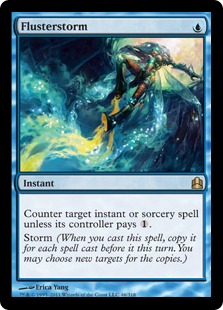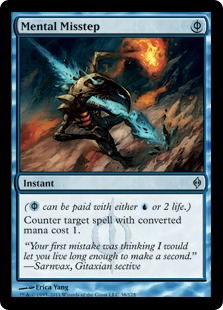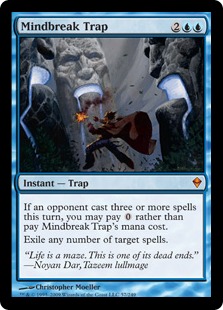We are now entering the stretch run of this series and will be going over Vintage’s traditional powerhouses.
Vintage’s Traditional Big Boys:
- Mishra’s Workshop
- Dredge
- Oath of Druids
- Gush
- Islands (Blue Decks)
- Dark Ritual
There will be no hiding the fact that for the most part a lot of the decks within their respective sections will be playing a lot of the same cards. What I want to discuss, starting in this article with Ritual decks, is the differences in card selection for each deck, why it matters, and what it means for that deck.
On the surface a lot of Vintage decks may look similar, but there is a reason why certain cards are or aren’t played within the same type of deck. Why it may seem like a subtle or insignificant inclusion or exclusion to most, card choices can have a dramatic effect on the outcome of a game. This is also why I wanted to start this part of the series with Dark Ritual decks; the effect on a Dark Ritual deck’s card selection is amplified more significantly than most of the other archetypes.
For purposes of this article we are defining Dark Ritual decks as decks that rely on Dark Ritual to power into a lethal Tendrils of Agony (Sorry Dark Times and Doomsday Gush, we already talked about you…). We are going to look at four separate Dark Ritual decks in this article:
- Bob Tendrils
- The Perfect Storm (TPS)
- Suicide
- Ad Nauseam Tendrils (ANT) Â
Like I previously mentioned, a lot of the cards within each of these archetypes will remain the same; however there are very distinct card choices in each which define the individual archetype and how it plays.
Where the Rituals At?!?!?
2011 was the second time in the history of Vintage Champs where not a single Dark Ritual was present in a Top 8 deck, the first being in 2005. Overall numbers across the board for Dark Ritual decks this year have been down, and there is a very good reason for this, three in particular if we are just talking about cards…
Two of the three (Flusterstorm and Mental Misstep) were both printed this year while the third (Mindbreak Trap) has been rapidly increasing in popularity thanks to the unrestricting of Gush, which led way to the massive influx of Gush decks; these decks trigger Mindbreak Trap more frequently than blue decks in the past. All blue decks have been incorporating these cards with increasing frequency this year and not surprisingly in the main deck, which doesn’t exactly make it a friendly environment for Dark Ritual-based decks. For a mere one mana or even potentially free, blue decks now come standard issue with the best weapons EVER against Dark Ritual-based decks, turning up the heat on even the best Ritual pilots.

Gush’s unrestriction also had a pretty big role in the decline of Dark Ritual-based decks. Gush really began to replace Dark Rituals as a storm generator for a lot of reasons. The obvious one being that Gush can’t be Mental Misstepped whereas Dark Ritual obviously can be. One of the bigger reasons is that it just gives you more options than a traditional Ritual-based deck. You are digging deeper into your deck and building more and more fuel at a steadier pace than that of a Dark Ritual-based deck. Gush storm decks also can be configured to include additional win conditions more easily as well as incorporate a heavy control package. If we look at Rich Shay Champs list, we can see that he has a couple different plans of attack to win (Jace, the Mind Sculptor and Tinker/Blightteel), whereas traditionally Dark Ritual-based decks are “all-in” on resolving a lethal Tendrils of Agony.
Creatures (1)
Planeswalkers (2)
Lands (15)
Spells (42)
- 1 Tendrils of Agony
- 1 Brainstorm
- 1 Fastbond
- 3 Mana Drain
- 1 Vampiric Tutor
- 1 Mystical Tutor
- 1 Yawgmoth's Will
- 1 Duress
- 4 Force of Will
- 1 Sol Ring
- 1 Regrowth
- 1 Demonic Tutor
- 2 Hurkyl's Recall
- 1 Time Walk
- 1 Ancestral Recall
- 1 Mana Crypt
- 4 Gush
- 1 Timetwister
- 1 Merchant Scroll
- 1 Tinker
- 1 Black Lotus
- 1 Mox Emerald
- 1 Mox Jet
- 1 Mox Pearl
- 1 Mox Ruby
- 1 Mox Sapphire
- 3 Preordain
- 4 Mental Misstep

Another thing Gush allows its pilots to do is to manage their role in a game more accordingly compared to that of Dark Ritual-decks. What I mean by that is Gush-based storm decks can switch between the control and “beatdown” roles more readily than Dark Ritual-based decks, which generally have to be the “beatdown.” Dark Ritual-based Storm decks are just flat out harder to pilot correctly and less forgiving than Gush-based storm decks, making Gush the obvious choice for most Storm pilots.
If the assignment of roles sounds foreign to you, I suggest reading Mike Flores masterpiece “Who is the Beatdown?” archived on this very site right here.
Anatomy of a Dark Ritual Deck
Like I previously mentioned, most decks within their respective sections for the remainder of the series will traditionally look the same. All of these decks will have the same core of cards in it no matter what for the most part. I want to briefly breakdown what we are going to see in most Dark Ritual decks.
Mana:
2 Underground Sea
4 Polluted Delta
2 Misty Rainforest
1 Island
1 Snow-Covered Island
1 Swamp
1 Snow Covered Swamp
1 Tolarian Academy
1 Mox Ruby
1 Mox Emerald
1 Mox Pearl
1 Mox Jet
1 Mox Sapphire
1 Black Lotus
1 Mana Crypt
1 Sol Ring
1 Mana Vault
4 Dark Ritual
1 Cabal Ritual
1 Lotus Petal
Here is a sample mana package taken from Mike Egan’s The Mana Drain Open 15 Top 8 list. For the most part, you want to incorporate anywhere from 3-4 basic lands in your Dark Ritual deck to help avoid getting stuck on mana due to Wastelands, which adds another layer of difficulty to this already challenging deck to play. Egan chose to incorporate four, which allows him to generate double black and double blue once all of his basics are in play, which will insure he can for the most part cast all of his spells. It should be noted that choosing to play Snow-Covered lands is a wise decision as well; it is still counted as a basic land for Wasteland purposes and can be included in a Gifts Ungiven package with a basic Island, Swamp, etc. Other than that, we see some pretty standard and self-explanatory stuff; restricted list of fast artifact mana, Dark Ritual, and Cabal Ritual, which is generally a one-of or a two-of in a Ritual deck.
Protection:
4 Force of Will
3/4 Duress/Thoughtseize
0-3 Mental Misstep
A recurring theme we will see throughout this article is the presence of Duress and Force of Will. Duress gives you the ability to check to see if the coast is clear for you to power out into a lethal Tendrils uninterrupted, which makes it a near staple for all Dark Ritual decks. (Although Thoughtseize is a fine albeit riskier choice due to the loss of life.) Force of Will is a pretty easy inclusion as well since it lets you pitch the majority of your deck to help protect yourself when you are attempting to storm out. More recently, Ritual decks have been adapting Mental Misstep, which serves as both a tempo spell for them and helps protect their own Dark Rituals.
Kill:
Pretty self-explanatory here, the deck’s primary and sometimes only win condition.
Bounce Package:
1 Hurkyl’s Recall
0-1 Rebuild
1 Chain of Vapor
We also will see some unusual maindeck inclusions with Chain of Vapor, Hurkyl’s Recall, and/or Rebuild. These cards provide the deck with an excellent answer to Workshop decks, a tougher matchup, and to Blightsteel Colossus. The key for their maindeck inclusion however stems from the fact that they can all be used to generate additional storm. All three can bounce your artifact mana (Sol Ring, Moxen, Mana Crypt, etc.) to help generate addition storm and/or mana to ensure your Tendrils of Agony is lethal.
Restricted List Goodies:
1 Demonic Tutor
1 Vampiric Tutor
1 Mystical Tutor
1 Ancestral Recall
1 Brainstorm
1 Ponder
1 Time Walk
1 Gifts Ungiven
1 Imperial Seal
1 Necropotence
1 Yawgmoth’s Will
Ritual decks look to use the best tutors and card advantage spells in the game to generate their storm counts. Here is a sample list of cards that one would obviously expect to be in a Ritual deck for the most part. As we go through more lists in this article, you will see deviations and inclusions from this sample list of restricted cards, but this is a great starting point for someone starting from scratch.
That will pretty much make up the core of most Dark Ritual-based decks in Vintage. What we will go over in this article is where the deviations come in, what cards fill up the additional flex and/or metagame spots, as well as the strengths and weakness of each Ritual archetype.
Storming Through Vintage
The modern Vintage metagame just hasn’t been the easiest for Ritual-based decks. 2011 began with the continued dominance of Workshop-based decks, which aren’t exactly a walk in the park for Rituals. As the year progressed, we saw Flusterstorm and Mental Misstep get printed, which as I explained are VERY GOOD against Ritual-based decks. As we approached the end of the year, we saw the rise of Landstill and the increased play of Mystic Remora, which again aren’t quite the decks you want to be playing against with Dark Rituals. Thanks to this influx of natural hate, Dark Ritual-based decks have seen a sharp decrease in Top 8s with only a mere 14 Dark Ritual-based Storm decks having Top 8ed a tournament this year in ALL Vintage tournaments; this includes events outside of the United States. Interestingly enough, we did see Dark Rituals Top 8 two of the three biggest Vintage tournaments in the United States this past year, the Top Deck Games Summer Open and The Mana Drain Open 15. The two Ritual decks to Top 8 were both Bob Tendrils and both piloted by New Yorker Mike Egan, who did not attend Vintage Champs… (Which leaves us wondering what if?!?)
Bob Tendrils
Creatures (4)
Lands (13)
Spells (43)
- 1 Sensei's Divining Top
- 1 Tendrils of Agony
- 1 Brainstorm
- 1 Cabal Ritual
- 1 Vampiric Tutor
- 1 Mystical Tutor
- 1 Yawgmoth's Will
- 3 Duress
- 4 Force of Will
- 1 Necropotence
- 1 Mana Vault
- 1 Sol Ring
- 1 Demonic Tutor
- 1 Hurkyl's Recall
- 1 Time Walk
- 4 Dark Ritual
- 1 Ancestral Recall
- 1 Mana Crypt
- 1 Timetwister
- 1 Gifts Ungiven
- 1 Mind's Desire
- 1 Merchant Scroll
- 1 Chain of Vapor
- 1 Tinker
- 1 Black Lotus
- 1 Lotus Petal
- 1 Mox Emerald
- 1 Mox Jet
- 1 Mox Pearl
- 1 Mox Ruby
- 1 Mox Sapphire
- 1 Ponder
- 3 Mental Misstep
Sideboard

Creatures (4)
Lands (14)
Spells (42)
- 2 Tendrils of Agony
- 1 Brainstorm
- 1 Cabal Ritual
- 1 Vampiric Tutor
- 1 Mystical Tutor
- 1 Yawgmoth's Will
- 3 Duress
- 4 Force of Will
- 1 Necropotence
- 1 Mana Vault
- 1 Sol Ring
- 1 Demonic Tutor
- 1 Hurkyl's Recall
- 1 Time Walk
- 4 Dark Ritual
- 1 Ancestral Recall
- 1 Mana Crypt
- 1 Timetwister
- 1 Gifts Ungiven
- 1 Mind's Desire
- 1 Merchant Scroll
- 1 Chain of Vapor
- 1 Demonic Consultation
- 1 Tinker
- 1 Rebuild
- 1 Black Lotus
- 1 Lotus Petal
- 1 Mox Emerald
- 1 Mox Jet
- 1 Mox Pearl
- 1 Mox Ruby
- 1 Mox Sapphire
- 1 Ponder

Why it works:
This is easily the most consistent and stable Dark Ritual deck we will go over today. Powered by Dark Confidant (Bob Maher’s Invitational Card aka Bob), the deck is equipped with exactly what Dark Ritual-based decks need to have against control decks, a card engine. Dark Confidant allows the deck to go toe to toe with the control decks of the format thanks to the card advantage and extra points of damage Dark Confidant can provide.
Egan decided to run Tinker/Blightteel in his builds, which as you will see later in this article isn’t something all Ritual decks necessarily do. In Egan’s case, he is looking to capitalize on the additional cards he is seeing by including a backup plan to fit with the deck’s ability to play a long game against control decks.
Where it works:
Because of Dark Confidant this deck is ideal for heavily blue-control-based metagames and quite capable in Mishra’s Workshop metas. The extra card advantage you can gain off of Dark Confidant really allows you to power through sphere effects and counters better than the rest of the Ritual decks we will be covering today. Thanks to Dark Confidant and the deck’s backup plan of Tinker/Blightteel, this Ritual deck probably has the best reach of the Ritual builds.
Where it might not work:
Due to Dark Confidant’s inclusion, the deck has draws that don’t always allow for it to have the speed traditionally associated with Dark Ritual decks. Some of the Tempo and Fish decks in the format might be able to give the deck some problems. You also will generally have a tougher game one against Dredge than the other Ritual decks, as this type of build is slower than its other Dark Ritual counterparts.
The Perfect Storm (TPS)
Creatures (1)
Lands (12)
Spells (47)
- 2 Tendrils of Agony
- 1 Brainstorm
- 2 Cabal Ritual
- 1 Yawgmoth's Bargain
- 1 Vampiric Tutor
- 1 Mystical Tutor
- 1 Yawgmoth's Will
- 1 Duress
- 4 Force of Will
- 1 Necropotence
- 1 Mana Vault
- 1 Sol Ring
- 1 Demonic Tutor
- 1 Hurkyl's Recall
- 1 Time Walk
- 4 Dark Ritual
- 1 Ancestral Recall
- 1 Imperial Seal
- 1 Mana Crypt
- 1 Timetwister
- 1 Gifts Ungiven
- 1 Mind's Desire
- 1 Memory Jar
- 2 Chromatic Sphere
- 1 Chain of Vapor
- 1 Tinker
- 1 Rebuild
- 1 Black Lotus
- 1 Lotus Petal
- 1 Mox Emerald
- 1 Mox Jet
- 1 Mox Pearl
- 1 Mox Ruby
- 1 Mox Sapphire
- 1 Repeal
- 1 Ponder
- 2 Preordain

Creatures (1)
Lands (13)
Spells (45)
- 1 Tendrils of Agony
- 1 Brainstorm
- 1 Cabal Ritual
- 1 Yawgmoth's Bargain
- 1 Vampiric Tutor
- 1 Mystical Tutor
- 1 Yawgmoth's Will
- 3 Duress
- 4 Force of Will
- 1 Necropotence
- 1 Mana Vault
- 1 Sol Ring
- 1 Demonic Tutor
- 1 Hurkyl's Recall
- 1 Time Walk
- 4 Dark Ritual
- 1 Ancestral Recall
- 1 Imperial Seal
- 1 Mana Crypt
- 1 Timetwister
- 1 Mind's Desire
- 1 Merchant Scroll
- 1 Chain of Vapor
- 1 Tinker
- 1 Black Lotus
- 1 Lotus Petal
- 1 Mox Emerald
- 1 Mox Jet
- 1 Mox Pearl
- 1 Mox Ruby
- 1 Mox Sapphire
- 1 Ponder
- 2 Preordain
- 3 Mental Misstep
Sideboard

Creatures (1)
Lands (14)
Spells (45)
- 1 Tendrils of Agony
- 1 Brainstorm
- 2 Cabal Ritual
- 1 Yawgmoth's Bargain
- 1 Vampiric Tutor
- 1 Mystical Tutor
- 1 Yawgmoth's Will
- 4 Force of Will
- 1 Necropotence
- 1 Mana Vault
- 1 Wheel of Fortune
- 1 Sol Ring
- 1 Demonic Tutor
- 1 Time Walk
- 4 Dark Ritual
- 1 Ancestral Recall
- 2 Grim Tutor
- 1 Mana Crypt
- 1 Windfall
- 1 Timetwister
- 1 Gifts Ungiven
- 1 Mind's Desire
- 1 Merchant Scroll
- 1 Memory Jar
- 1 Thirst for Knowledge
- 1 Chain of Vapor
- 2 Misdirection
- 1 Tinker
- 1 Rebuild
- 1 Black Lotus
- 1 Fact or Fiction
- 1 Mox Emerald
- 1 Mox Jet
- 1 Mox Pearl
- 1 Mox Ruby
- 1 Mox Sapphire

Why it works:
The Perfect Storm (TPS) is probably the most “pure” Dark Ritual Storm deck we will cover in this article. What I mean by that is this deck uses its flex slots for traditional storm-generating engines and draw-sevens, Mind’s Desire, Memory Jar, Yawgmoth’s Bargain, Timetwister, etc. Jay Rodriguez’s build is probably the furthest in deviation from most builds you will see. In addition to Tinker/Blightteel from all three lists, Jay took it another step further in adding Empty the Warrens in his sideboard for yet another additional win condition, which conveniently fits into the deck’s core strategy. Additionally Jay plays Grim Tutor, one of Vintage’s last unrestricted tutors; Grim Tutor is a great inclusion for any TPS style deck due to the fact it can be cast easily off a Ritual.
Where it works:
This style of Ritual deck has a great balance of being powerful and fast compared to the other Ritual decks in the format. That allows this type of Ritual deck to be an excellent choice for an unknown metagame being that it is very versatile no matter the field. It has the right combination of speed and consistency to have good matchups across the board for the most part. The deck’s storm engines and draw-sevens allow it to potentially power through opposing Missteps, while the deck’s speed make it a real threat to Dredge and Fish-based strategies.
Where it might not work:
The deck’s general reliance on three-or-more-mana spells and lack of real draw engine can make Workshop strategies, especially on the draw, very difficult to beat. The deck can also be stuck in draw-go situations when facing opposing discard spells, which makes playing against opposing Ritual decks equivalent to flipping coins.
Suicide
Creatures (1)
Lands (12)
Spells (47)
- 1 Tendrils of Agony
- 1 Brainstorm
- 1 Cabal Ritual
- 1 Yawgmoth's Bargain
- 1 Vampiric Tutor
- 1 Mystical Tutor
- 1 Yawgmoth's Will
- 4 Force of Will
- 1 Necropotence
- 1 Mana Vault
- 1 Sol Ring
- 1 Demonic Tutor
- 1 Hurkyl's Recall
- 1 Time Walk
- 4 Dark Ritual
- 1 Ancestral Recall
- 1 Imperial Seal
- 1 Mana Crypt
- 1 Timetwister
- 1 Gifts Ungiven
- 1 Mind's Desire
- 1 Merchant Scroll
- 1 Memory Jar
- 1 Chain of Vapor
- 1 Tinker
- 1 Black Lotus
- 1 Lotus Petal
- 1 Mox Emerald
- 1 Mox Jet
- 1 Mox Pearl
- 1 Mox Ruby
- 1 Mox Sapphire
- 1 Ponder
- 4 Thoughtseize
- 4 Gitaxian Probe
Sideboard

Creatures (3)
Lands (16)
Spells (41)
- 2 Tendrils of Agony
- 2 Cabal Ritual
- 1 Vampiric Tutor
- 1 Yawgmoth's Will
- 4 Duress
- 1 Necropotence
- 1 Sol Ring
- 1 Demonic Tutor
- 1 Hurkyl's Recall
- 4 Dark Ritual
- 1 Ancestral Recall
- 1 Imperial Seal
- 2 Grim Tutor
- 4 Cabal Therapy
- 4 Night's Whisper
- 1 Demonic Consultation
- 1 Black Lotus
- 1 Lotus Petal
- 1 Lion's Eye Diamond
- 1 Mox Jet
- 1 Mox Sapphire
- 1 Extirpate
- 4 Gitaxian Probe

Why it works:
Here we can begin to see some distinct differences in how a Dark Ritual deck can operate, particularly by living on the edge in terms of life totals. I want to start with the first list, since it is the closest to what we have been going over thus far in this article.
Rob has a pretty standard Ritual list compared to the previous two sections minus eight cards. He decided to go with four Gitaxian Probe and four Thoughtseize rather than using some of the more conventional card drawing and discard spells. Gitaxian Probe gives Rob the advantage of knowing what his opponent has, drawing a card, generating storm, and saving his mana for two life. Thoughtseize’s stock is also rapidly increasing thanks to the large influx of Fish, Gro, and Tempo decks appearing in the format. Rob gets the same advantages as Duress with the added effect of being able to hit potentially annoying creatures (Gaddock Teeg, Lodestone Golem, Dark Confidant, etc.) while remaining relevant in the Workshop matchup all for the cost of two life.
Vincent Forino’s near mono-black list is just the first step to another near mono-black Ritual deck we will be covering shortly. His is considerably different from any of the other Ritual decks we will go over in this article, being that it operates in a completely different fashion.
Vincent’s deck uses a draw-heavy build to generate a huge storm count as quickly as he can before dying to his own life-intensive cards. Night’s Whisper, Dark Confidant, and Gitaxian Probe provide a very smooth and consistent yet dangerous assortment of card-drawing power. Probe pairs well with the maindeck Cabal Therapy to act as a pseudo-Thoughtseize if he needs to hit an important creature his opponent might have, while potentially making Cabal Therapy a possible two-for-one. Cabal Therapy also provides a nice way to get rid of a Dark Confidant if you are nearing death. His heavy discard package paired with his Fish-style mana denial package (Wasteland, Strip Mine, and Null Rod in the sideboard) allow Vincent to play a variety of roles at anytime within a game.
Where it works:
These types of Ritual decks are ideal in metagames where creatures and Fish decks are at a minimum. This style of deck is most advantageous in a blue control or prison-styled Workshop metagame where information and mana are at premiums. The deck’s utilization of Gitaxian Probe really gives the deck an edge when under sphere effects or staring down a control player’s grip of seven cards.
Where it might not work:
The suicidal style the deck uses doesn’t allow the deck much room for error, and mistakes with the deck are amplified even more when playing against a deck filled with creatures. Aggressive Workshop strategies and Tempo Fish decks can really give this style of Ritual deck nightmares.
Ad Nauseam Tendrils (ANT)
Lands (13)
Spells (47)
- 2 Tendrils of Agony
- 1 Brainstorm
- 2 Cabal Ritual
- 1 Vampiric Tutor
- 1 Mystical Tutor
- 1 Yawgmoth's Will
- 4 Duress
- 1 Necropotence
- 1 Mana Vault
- 1 Sol Ring
- 1 Demonic Tutor
- 2 Hurkyl's Recall
- 4 Dark Ritual
- 1 Ancestral Recall
- 1 Mana Crypt
- 2 Chain of Vapor
- 1 Demonic Consultation
- 1 Black Lotus
- 1 Lotus Petal
- 1 Mox Jet
- 1 Mox Sapphire
- 3 Chrome Mox
- 4 Pact of Negation
- 1 Ponder
- 1 Thoughtseize
- 4 Ad Nauseam
- 3 Preordain

Lands (11)
Spells (49)
- 4 Tendrils of Agony
- 1 Brainstorm
- 4 Cabal Ritual
- 1 Vampiric Tutor
- 1 Mystical Tutor
- 1 Yawgmoth's Will
- 4 Duress
- 1 Necropotence
- 1 Mana Vault
- 1 Sol Ring
- 1 Demonic Tutor
- 4 Dark Ritual
- 1 Ancestral Recall
- 1 Imperial Seal
- 1 Mana Crypt
- 4 Chain of Vapor
- 1 Demonic Consultation
- 1 Black Lotus
- 1 Lotus Petal
- 1 Mox Jet
- 1 Mox Sapphire
- 4 Chrome Mox
- 4 Pact of Negation
- 1 Ponder
- 4 Ad Nauseam
Sideboard

Why it works:
Here we have a Ritual’s equivalent of Goblin Charbelcher, Ad Nauseam Tendrils (ANT). ANT is a very all-in type of deck, similar to the Goblin Charbelcher deck I referenced last article. ANT focuses on one thing, resolving an Ad Nauseam. Then you want to get as many cards as you can without risking death and then produce a lethal Tendrils of Agony with all of the cards gained from that Ad Nauseam. The deck relies on a similarly heavy discard package that Vincent’s Sui Black deck ran to ensure when it casts Ad Nauseam it resolves. It also runs Pact of Negation to help force through an Ad Nauseam, only adding to the fact once you Ad Nauseam, you’re all in!! The deck looks to utilize cheap spells and mana sources to ensure as many cards as possible from a resolved Ad Nauseam, often relying on Chrome Mox to help generate mana by imprinting an extra card.
Where it works and where it might not work:
The deck’s speed is its primary advantage and disadvantage. A timely series of counterspells or even one counterspell can really derail the deck, leaving you with a bunch of mana and nothing to do with it. The deck is very linear in play for the most part, almost equivocal to Dredge, relying on generating a game plan to resolve an Ad Nauseam as fast as possible. The deck is based on surprise and speed, making determining what you keep for your opening hand very critical for this deck. This also leads to the deck having some consistency issues due to the fact you can draw a lot of hands that just do nothing. A lot of people may be put off by this style of deck, but it can really sneak up on a tournament and take it by surprise. Pretty much the only thing you don’t want to sit down across from with this deck is Workshop-based decks, especially on the draw. Ritual decks all have generally unfavorable Workshop matchups, but this style of deck really amplifies it.
Due to the all-in nature of the deck, you need to have a strong sideboard to help combat the field. Roger Lladó’s sideboard gives you some great options with a board that lets you transform into an Oath of Druids deck as well as being able to protect yourself with Xantid Swarm. Seth’s list looks to load up on answers for the deck’s notoriously bad matchup, Workshops. As I mentioned, the card advantage generated by Dark Confidant is great against both control and Workshop decks, giving Seth that added flexibility by using Dark Confidant. If you’re feeling adventurous, ANT is the deck for you.
Storming in the Future
What is interesting to note is that the majority of Ritual decks that did Top 8 did so towards the end of this past year, particularly after Vintage Champs. The modern Vintage metagame is in constant flux at the moment, and with Workshop strategies diminishing from their dominant numbers at the beginning of last year, it looks like creatures are beginning to run rampant in Vintage. This is why I believe Ritual-based decks are poised for a comeback as evidenced by the deck’s successful December results.
As the number of Mental Missteps begin to fall and two (Oath of Druids, Tarmogoyf, Dark Confidant, Standstill, Null Rod, Snapcaster Mage, etc.) becomes the new one, it looks to be clearing out for Ritual-based decks. As Forgemaster Shop decks, Tarmogoyfs, Delver of Secrets, and Snapcaster Mages begin to litter the Vintage metagame, it is only a matter of time before blue strategies begin to adapt.
Flusterstorm isn’t countering nearly as much now as it did when it first hit print right now, which may lead to a Ritual deck resurgence while this metagame is still evolving. I can’t really stress it enough, but the only major deterrent to a Ritual resurgence right now I feel is the difficulty of the deck. If you do decide to pick up one of the Ritual decks, make sure you practice as much as you can before you play in a tournament. It is one of the most difficult decks in the format to pilot correctly and easily the least forgiving of any type of deck in Vintage.

That’s a wrap for this article; next time we will be moving into Vintage’s other primary combo engine, Oath of Druids.Â
@Womba_ on Twitter



